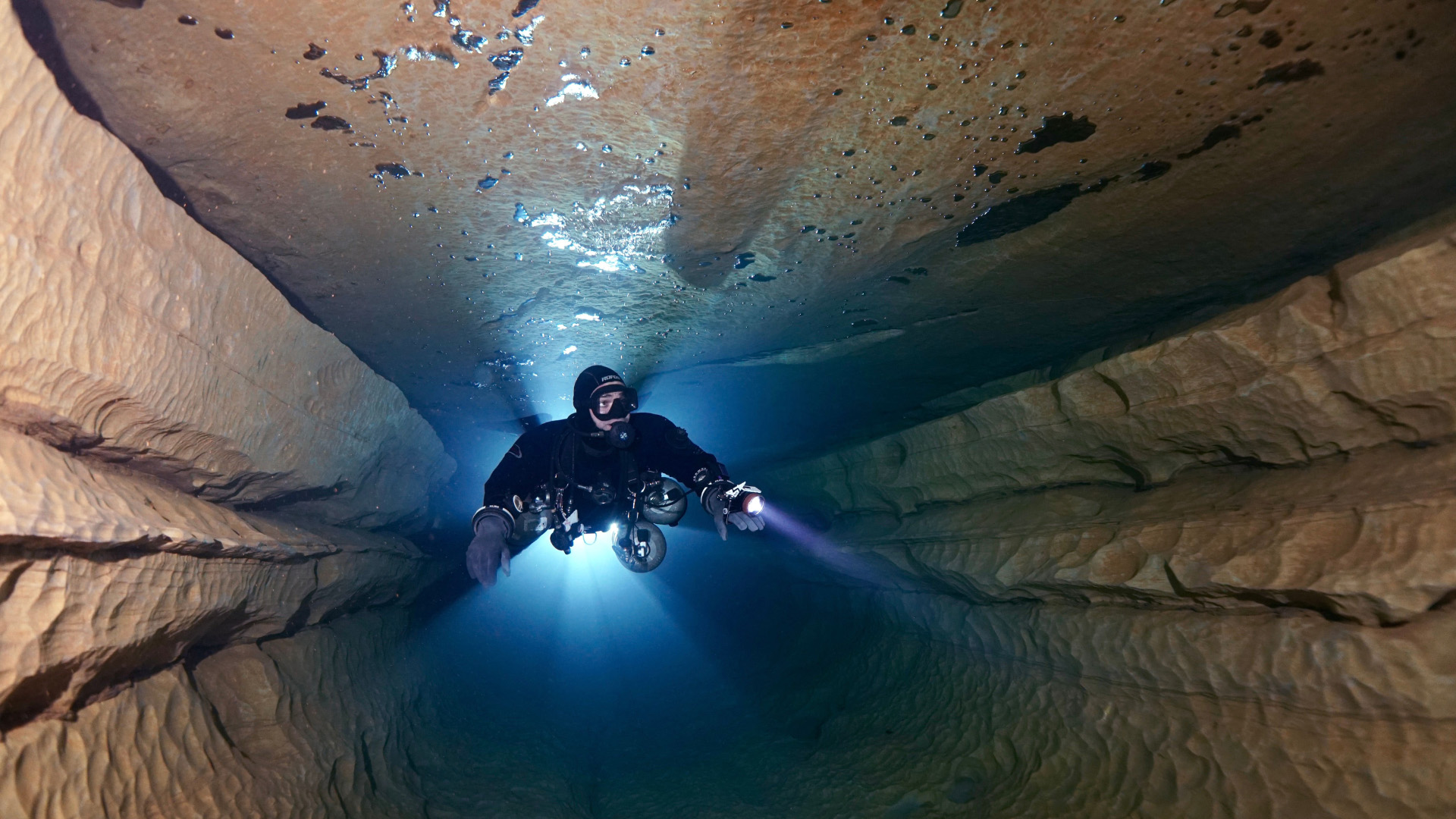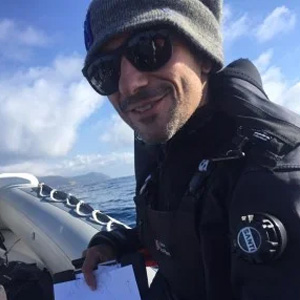Cave diving represents one of the most fascinating and technically challenging frontiers in the underwater world. Unlike open-water diving, which captivates with its vibrant marine ecosystems, cave diving offers a more introspective and mysterious experience, inviting daring explorers to venture into the silent recesses of the planet. This type of diving is not for everyone: it requires special training, appropriate equipment, and a calm temperament, but in return, it offers the opportunity to traverse submerged spaces where few have dared to venture.
Each cave dive is a journey through Earth’s geological history, with rock formations that tell millennia-old stories and aquatic environments that hide unique species, adapted to live in eternal darkness. The challenges are significant, from navigating environments with reduced visibility to managing potentially dangerous situations far from the surface. Yet, for those who are ready to accept these risks, the rewards are unparalleled: the extraordinary beauty of submerged caves, the thrill of discovering pristine places, and the pure joy of pushing one’s limits.
In this article, we will explore the enigmatic world of cave diving, from the skills and equipment necessary to undertake these adventures, to the most spectacular destinations where divers can test their abilities. Whether you are an experienced diver looking for your next big challenge or an enthusiast curious about this extreme discipline, we will dive into everything that makes cave diving an unmatched experience.

What is cave diving?
Cave diving is an exciting and technically demanding specialization in the world of scuba diving. This practice takes place in submerged underground environments, such as caves and caverns, which are completely filled with water or have partial sections of immersion. Unlike free-water diving, cave diving requires the use of specific equipment, advanced techniques, and considerable experience, as the environments in which it is practiced can be complex and potentially dangerous.
Cave divers must be able to navigate enclosed environments with limited visibility and often use a guideline, a cable or rope fixed at the entrance of the cave, which serves as a reference to find the way out. It is essential to have a thorough knowledge of one’s equipment and a high level of comfort in potentially stressful situations. In addition, careful dive planning and careful management of air reserves are essential, given the lack of direct access to the surface in case of an emergency.
Cave diving offers the opportunity to explore unique and breathtaking environments, witnessing millennia-old rock formations, stalactites and stalagmites underwater, and specialized aquatic life that adapts to these dark and tranquil environments. For those seeking an underwater adventure that goes beyond the ordinary, cave diving represents an exciting and rewarding challenge.
Is a license required for cave diving?
Yes, a specific license is absolutely necessary to perform cave diving. This specialization requires a set of skills and technical knowledge that go beyond those required for standard recreational diving. The certification process for cave diving involves several levels of training, each of which prepares the diver to face the unique challenges and potential dangers of this type of underwater environment.
The process begins with the UTD Overhead Protocols course, which introduces the fundamental skills needed to move in obstructed environments, such as the positioning and removal of the guideline, navigation in the absence of visibility, and the management of emergencies such as sudden air loss or equipment failures. This course is a prerequisite for accessing subsequent levels of wreck (Wreck Penetration) and cave (Cave Diving) diving.
After completing the basic course, students can proceed with UTD Cave 1, which covers the basic techniques for cave diving and introduces navigation following a main guideline. The course emphasizes the importance of situational awareness, detailed dive planning, stress management, and the conservation of the delicate settings of caves.
The path is completed with UTD Cave 2, which further refines cave diving skills, allowing divers to safely navigate through complex environments and penetrate lateral passages and tunnels.
Each course is structured to ensure that divers acquire the skills necessary to handle the situations they may encounter during cave diving, with a strong emphasis on safety and respect for the environment. Therefore, the certification not only attests to a diver’s ability to dive in caves, but also ensures that they are prepared to do so in a responsible and informed manner.
What is the difference between cave diving and open sea diving?
Cave diving and open sea diving represent two very different experiences in the vast world of scuba diving, each with its own environmental specifics, techniques, equipment, and levels of risk.
When we talk about cave diving, we refer to a type of diving that takes place in enclosed and underground environments such as submerged caves or caverns. These places are often devoid of natural light, characterized by restricted spaces, and can have very limited visibility. Not only that, the absence of direct access to the surface adds an additional level of complexity and risk. Divers who explore these depths use specialized techniques, such as navigation with guide lines to not lose orientation and manage situations such as zero visibility or loss of the guide line itself. Moreover, it is essential to carry specific equipment such as multiple lighting systems, redundant regulator configurations, and in some cases, rebreathers to optimize gas consumption in confined environments.
On the other hand, open sea diving takes place in vast and open environments such as oceans and large lakes, where divers always have the possibility to ascend directly to the surface. Visibility is often good, and natural and artificial landmarks help in orientation. The techniques used are generally less complex compared to those required for cave diving. Even the equipment can be less demanding, with the need for only one set of regulators and a dive computer to monitor depth and dive time.
Open sea diving is perceived as less risky compared to cave diving. In the sea, the main concerns include managing currents, marine life, and potential decompression issues, but the possibility of a direct ascent in case of an emergency provides a significantly greater safety margin.
Furthermore, while basic certifications are sufficient to dive in open waters, exploring submerged caves safely requires specific and extensive training. This includes not only learning advanced techniques but also serious preparation to manage the unique challenges of these environments below the surface.
What can you see during a cave dive?
A cave dive offers a completely different and often more mysterious visual experience compared to those in open waters. Submerged caves are unique environments, rich in natural phenomena and geological formations that are not found elsewhere. Here are some of the wonders you can expect to see during a cave dive:
Rock formations
Submerged caves often feature stunning rock formations such as stalactites and stalagmites, columns, and drapes of limestone. These structures form over thousands of years through the deposition of minerals brought by water seeping through. Observing these delicate natural artworks up close is a fascinating experience.
Specialized aquatic life
Submerged caves are the habitat of aquatic life species that have adapted to survive in conditions of almost total darkness. This includes blind fish, shrimp, and other invertebrates, many of which are albino and are not found in any other environment.
Light effects
One of the most spectacular aspects of cave diving are the light effects that occur when rays of sunlight filter through openings in the rock, creating almost surreal underwater beams of light. These light plays offer breathtaking photographic opportunities and add an ethereal element of beauty to the cave environment.
Narrow passages and large halls
Caves can range from narrow passages that require precise navigation skills to immense submerged caverns that open into spacious halls. Exploring these different structures is exciting and offers a variety of experiences during a single dive.
Archaeological and historical artifacts
In some submerged caves, you can find archaeological or historical artifacts. These can include remains of ancient civilizations, such as pottery and tools, or even exceptionally preserved human and animal remains due to the particular conditions of the cave environment. Some caves have also been used as ritual sites or burial places.
Isolation and silence
Beyond what can be seen, the experience of being in such an isolated and quiet environment is something unique to cave diving. The silence can be almost palpable, interrupted only by the sound of one’s own breathing and bubbles.
Cave diving thus offers a unique combination of technical challenges, natural wonders, and tranquility that attracts many divers seeking a different experience from that offered by open waters.
If you are fascinated by the idea of exploring the submerged world of caves and wish to venture into these dives with the guidance of experts, Argentario Divers is ready to welcome you. With extensive experience in cave diving and a team of qualified instructors, Argentario Divers offers specific training courses and guided dives that will allow you to safely discover the hidden wonders beneath the surface.
For more information on available courses, requirements, and upcoming underwater adventures, do not hesitate to contact Argentario Divers. You can reach the center by phone, email, or by visiting our website directly. Do not miss the opportunity to transform your passion for diving into an unforgettable adventure among submerged caves!



